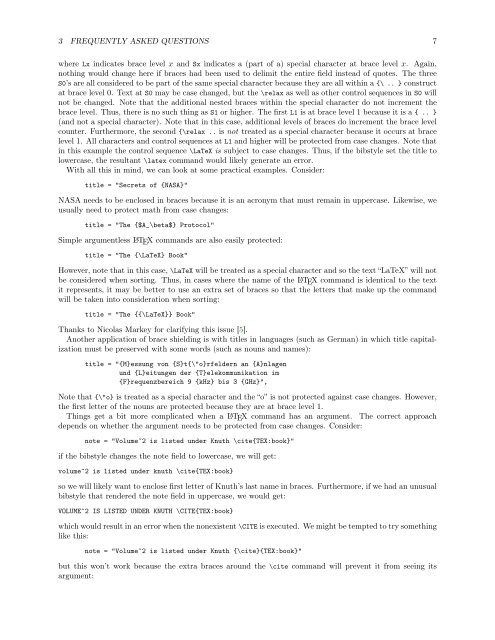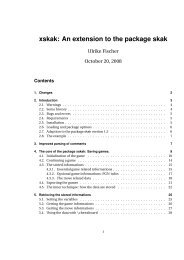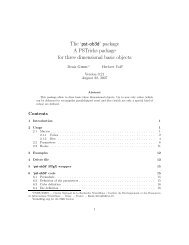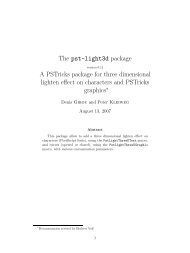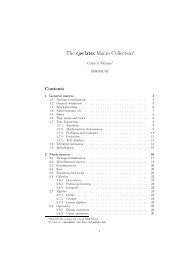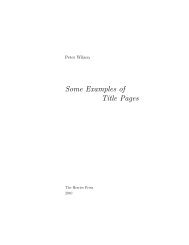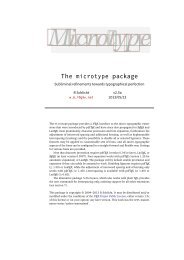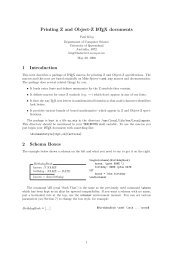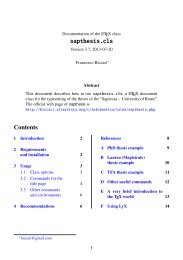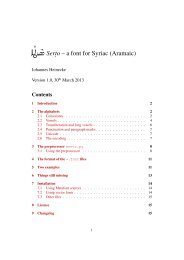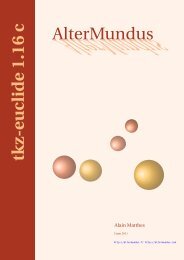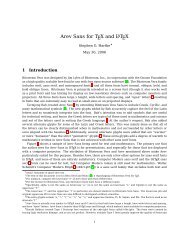BibTeX Tips and FAQ - Parent Directory
BibTeX Tips and FAQ - Parent Directory
BibTeX Tips and FAQ - Parent Directory
Create successful ePaper yourself
Turn your PDF publications into a flip-book with our unique Google optimized e-Paper software.
3 FREQUENTLY ASKED QUESTIONS 7where Lx indicates brace level x <strong>and</strong> Sx indicates a (part of a) special character at brace level x. Again,nothing would change here if braces had been used to delimit the entire field instead of quotes. The threeS0’s are all considered to be part of the same special character because they are all within a {\ .. } constructat brace level 0. Text at S0 may be case changed, but the \relax as well as other control sequences in S0 willnot be changed. Note that the additional nested braces within the special character do not increment thebrace level. Thus, there is no such thing as S1 or higher. The first L1 is at brace level 1 because it is a { .. }(<strong>and</strong> not a special character). Note that in this case, additional levels of braces do increment the brace levelcounter. Furthermore, the second {\relax .. is not treated as a special character because it occurs at bracelevel 1. All characters <strong>and</strong> control sequences at L1 <strong>and</strong> higher will be protected from case changes. Note thatin this example the control sequence \LaTeX is subject to case changes. Thus, if the bibstyle set the title tolowercase, the resultant \latex comm<strong>and</strong> would likely generate an error.With all this in mind, we can look at some practical examples. Consider:title = "Secrets of {NASA}"NASA needs to be enclosed in braces because it is an acronym that must remain in uppercase. Likewise, weusually need to protect math from case changes:title = "The {$A_\beta$} Protocol"Simple argumentless L A TEX comm<strong>and</strong>s are also easily protected:title = "The {\LaTeX} Book"However, note that in this case, \LaTeX will be treated as a special character <strong>and</strong> so the text “LaTeX” will notbe considered when sorting. Thus, in cases where the name of the L A TEX comm<strong>and</strong> is identical to the textit represents, it may be better to use an extra set of braces so that the letters that make up the comm<strong>and</strong>will be taken into consideration when sorting:title = "The {{\LaTeX}} Book"Thanks to Nicolas Markey for clarifying this issue [5].Another application of brace shielding is with titles in languages (such as German) in which title capitalizationmust be preserved with some words (such as nouns <strong>and</strong> names):title = "{M}essung von {S}t{\"o}rfeldern an {A}nlagenund {L}eitungen der {T}elekommunikation im{F}requenzbereich 9 {kHz} bis 3 {GHz}",Note that {\"o} is treated as a special character <strong>and</strong> the “o” is not protected against case changes. However,the first letter of the nouns are protected because they are at brace level 1.Things get a bit more complicated when a L A TEX comm<strong>and</strong> has an argument. The correct approachdepends on whether the argument needs to be protected from case changes. Consider:note = "Volume˜2 is listed under Knuth \cite{TEX:book}"if the bibstyle changes the note field to lowercase, we will get:volume˜2 is listed under knuth \cite{TEX:book}so we will likely want to enclose first letter of Knuth’s last name in braces. Furthermore, if we had an unusualbibstyle that rendered the note field in uppercase, we would get:VOLUME˜2 IS LISTED UNDER KNUTH \CITE{TEX:book}which would result in an error when the nonexistent \CITE is executed. We might be tempted to try somethinglike this:note = "Volume˜2 is listed under Knuth {\cite}{TEX:book}"but this won’t work because the extra braces around the \cite comm<strong>and</strong> will prevent it from seeing itsargument:


